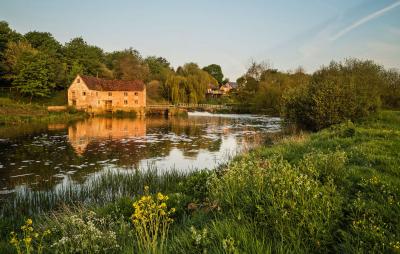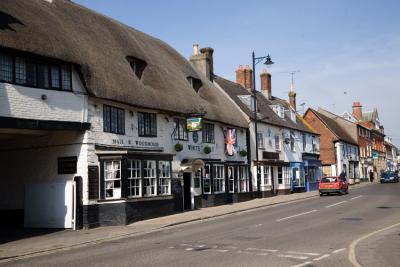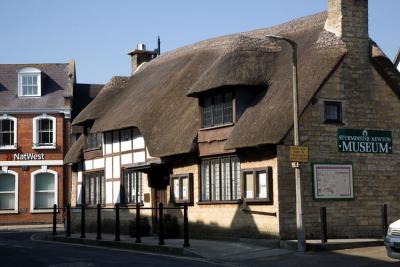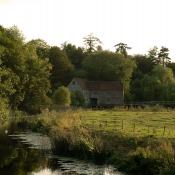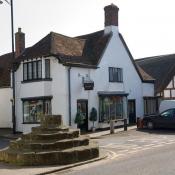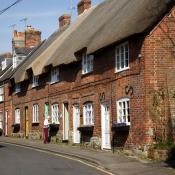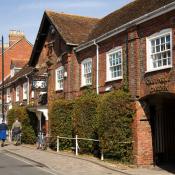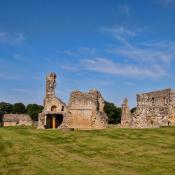
Sturminster Newton is a pretty Dorset town, in the Stour farmlands, where there has been a market since 1272. It is situated in the beautiful Blackmore Vale, between Sherborne and Blandford Forum. There are several rivers in the area, the largest of which is the River Stour, which flows south from its source in Somerset, and turns south east at Sturminster Newton. The river offers high quality fishing and continues past Bournemouth, before joining the river Avon at Christchurch to flow into the sea.
A 15th century mediaeval bridge, with six arches over the river, still carries the penalty of “Transportation for life” for anyone who damages it. This bridge is the one featured in the poem “On Sturminster Bridge” by Thomas Hardy. Hardy wrote his novel “The Return of the Native” whilst living in Sturminster Newton in Riverside, a stone mansion on the edge of town.
The 17th century Sturminster Newton Water Mill, with its impressive weir, is situated to the south of the town, about 250 yards upstream from the town bridge. It is still working, and can be visited on open days. The original mill was Newstone Castele Mill and is recorded in the Domesday Book, but the present building dates from the 17th and 19th centuries. The wooden porticoed mill house is on the road to Blandford Forum, opposite an imposing a thatched house. Further on, Newton House has a Georgian façade but is much older. There is a strange medallion frieze above the front door of this house.
There are the ruins of a small 14th-century castle, on the Newton side of the river. A report in 1865 states that there was originally a Roman structure on this site and describes the ruins as a keep, within a vallum and ditch, seated on a hill. Within the town is a wide range of architecturally interesting and thatched, timber-traced buildings. The Perpendicular church of St Mary was rebuilt in 1486 and has a carved wagon roof. There are a number of bow-windowed buildings of brick, stone and cob, especially on the streets leading to the attractive market square. The White Hart Inn is an 18th century thatched building.
The town has a Museum which is housed in a converted Victorian Chapel in Bath Road. It has been in existence for about ten years and shows displays of local social history from town and the surrounding areas. The museum is open during the summer season.
In 1863, the Dorset Central Railway completed the stretch of line from Blandford to Templecombe. Sturminster Newton was later connected to the national rail system, when this line was joined to that of the Somerset Central Railway at Cole. Unfortunately, the railways have long since bypassed this little town.
Dorset's 19th century poet, William Barnes, who is perhaps best remembered for the words of the song “Linden Lea” was born at Pentridge Farm, just outside Sturminster Newton. Barnes was said to have composed much of his work around the fields and River Stour in this part of his beloved Dorset, particularly around the area of the picturesque Fiddleford Mill.
This mill house stands a mile or two away from the town and traffic, by a mill pond and weir, in the most beautiful setting. Fiddleford Mill was once a hiding place for contraband liquor.
The nearby restored manor house is one of the oldest buildings in Dorset, dating from the 14th century. Both the Great Hall and Solar have complex and beautiful 600 year old timber roofs. Amongst alterations effected in the 16th century is a typical Tudor plaster ceiling.
Sturminster Newton is a lovely centre from which to explore the surrounding area and there are lovely countryside walks along the riverbank. Some of these pass one or more of the three mill pools. The town has a number of pubs, restaurants and cafés, plus plenty of accommodation for visitors.
A carnival is held each year during August. It includes a children’s parade, carnival floats, bands and a fancy dress parade, in addition to various other events during the carnival week. The town is also in a convenient location for the Great Dorset Steam Fair at Tarrant Hinton, held in early September each year. This is one of the world’s biggest steam fairs with thousands of exhibits and attractions, including a large fun fair. Another event in early September is a must for “foodies”. This is the Sturminster Newton Cheese Festival, which is by no means confined just to cheese.

